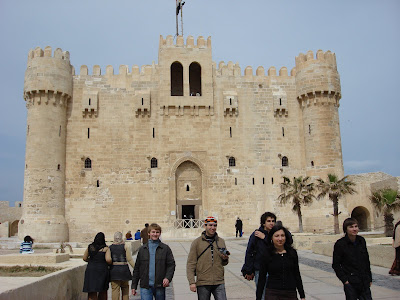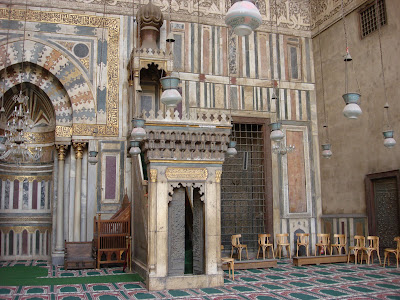 …..and I’ve really come to like this country. Monday morning I got up early and took the final tour I’ve wanted to do: Coptic Christian Cairo and the Citadel overlooking the city.
…..and I’ve really come to like this country. Monday morning I got up early and took the final tour I’ve wanted to do: Coptic Christian Cairo and the Citadel overlooking the city.The day was cool and overcast so it was a good day to be inside. We started with a visit to the Citadel—home to Egypt’s rulers for over 700 years. The huge Mosque of Mohammed Ali towers over the city—I can see it in the background from my hotel room across the city.
The Mohammed Ali Mosque is relatively new—built in the 1850s and is unusual in that it i
 s Turkish in design but it has still become the symbol of the City of Cairo. Like most mosques here, the outer court is open-air and contains an ornamental fountain for the ritual cleansing before prayers. There is also a large clock here—the gift of the French in return for one of the giant obelisks from the Temple of Luxor. Problem is, the clock has never worked and still doesn’t today and the French are still keeping the obelisk.
s Turkish in design but it has still become the symbol of the City of Cairo. Like most mosques here, the outer court is open-air and contains an ornamental fountain for the ritual cleansing before prayers. There is also a large clock here—the gift of the French in return for one of the giant obelisks from the Temple of Luxor. Problem is, the clock has never worked and still doesn’t today and the French are still keeping the obelisk.Inside, it is much larger than the two old, historic mosques I visited Saturday and the overall theme is the color red. It truly is massive and far better lit which, with the red
 carpeting, gives it a hotel lobby ambiance. The Granite work is amazing—especially on the niche that points to Mecca and on the elevated pulpit for the Imam to make his calls to prayers. As amazing as this mosque was, I still prefer the two historic Mosques of Sultan Hassan and ar-Rifai because of their age and histories.
carpeting, gives it a hotel lobby ambiance. The Granite work is amazing—especially on the niche that points to Mecca and on the elevated pulpit for the Imam to make his calls to prayers. As amazing as this mosque was, I still prefer the two historic Mosques of Sultan Hassan and ar-Rifai because of their age and histories.From the mosque we visited some of the Coptic Christian Churches of Cairo—and there are several. For a period, Egypt was a Christian nation and came under occupation and persecution by the Romans. Partially in response to the Romans, the Copts requested Muslims come to Egypt and the result was that Islam became the predominant religion—80% Islam, 15% Coptic Christian and various other beliefs. Although it hasn’t been a
 perfect relationship, the two religions do seem to exist peacefully and are literally side-by-side in this old part of Cairo.
perfect relationship, the two religions do seem to exist peacefully and are literally side-by-side in this old part of Cairo.According to tradition, St. Mark, one of the 12 Apostles, introduced Christianity into Egypt—starting in Alexandria in the first century. As the religion spread, it did so separate from Rome and therefore is an Orthodox Christian creed. From Moses to Jesus’ family’s exile in Egypt after his birth, Egypt has been important to Jews and Christians. One of the churches here, the Church of St. Sergius, is built over a cave that is believed to have been one of the places the Holy Family took shelter during their flight into Egypt. C
 ameras were not allowed inside, which is a shame because it is a very unusual ancient church with beautiful icons but we did get to see the crypt.
ameras were not allowed inside, which is a shame because it is a very unusual ancient church with beautiful icons but we did get to see the crypt.We also visited the Church of St. Barbara, long one of my favorite saints, who was martyred after her father killed her for trying to convert him to Christianity. This church did allow photos and I’m including one here. The most prominent features were the artwork, dating back to the 1700s.
Along the route we stopped at the historic Ben Ezra Synagogue. After the Roman expulsion of Jews from Jerusalem in the first century AD, Egypt
 became the center of Judaism—a presence that lasted here until 1948. By that time the numbers had dwindled and when Israel was created in 1948—with the resulting war with Egypt—the remaining Jews were forced out here. Today there is a miniscule presence and one active synagogue in the city center. This synagogue is inactive but has been meticulously preserved and is open to the public. Again, photos weren’t allowed inside.
became the center of Judaism—a presence that lasted here until 1948. By that time the numbers had dwindled and when Israel was created in 1948—with the resulting war with Egypt—the remaining Jews were forced out here. Today there is a miniscule presence and one active synagogue in the city center. This synagogue is inactive but has been meticulously preserved and is open to the public. Again, photos weren’t allowed inside.The final church on the tour was the famous “Hanging Church,” a misnomer in that nobody was ever hung here. It is the most beautiful of the Coptic Churches and is so called because it was built over the old Water Gate of the Roman fortress of Babylon—probably around fourth century A.D. Constructed
 over the Water Gate, the church was thus “suspended” and therefore the name “Hanging Church.” The artwork is spectacular and the church features ornate marble on the columns and pulpit. I am posting a photo of the interior here.
over the Water Gate, the church was thus “suspended” and therefore the name “Hanging Church.” The artwork is spectacular and the church features ornate marble on the columns and pulpit. I am posting a photo of the interior here.Tomorrow morning I head back to Paris and then to Houston. This has been a good trip—even Cameroon was a better assignment this time—and Egypt is one of the most impressive countries I’ve visited so far…..




































